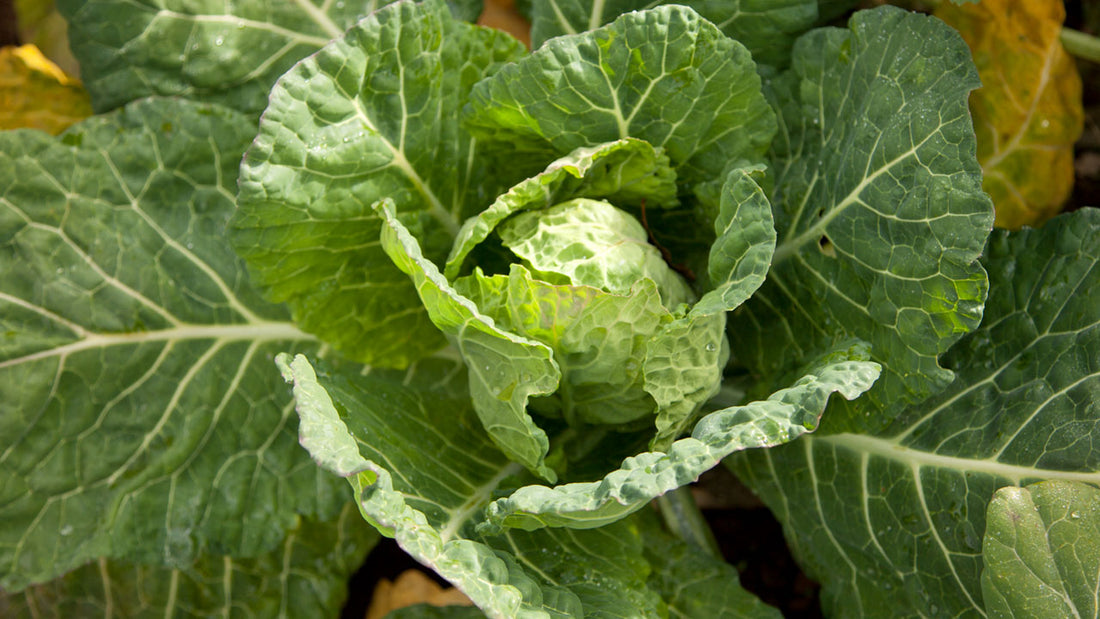Cabbage, in one form or another, has been around since 4,000 B.C, with evidence of cultivation in the Shensi province of China. It can be enjoyed fresh in a slaw salad, cooked in a great dish like corned beef and cabbage or fermented into sauerkraut or kimchi. However you like to eat it, cabbage comes in several forms and can be planted late summer or spring (depending on where you live). In our video on
Growing Organic Cabbage, Tricia shows just how easy it is to grow cabbage.
Types of Cabbage
 Savoy
Savoy - crinkled leaves that form heads, most very frost-tolerant cabbage variety
Green - produces tight heads, traditional type found at the grocery store. We offer the
Golden Acre variety which produces smaller heads (about 5-7") and are ideal for small gardens.
Red- beautiful red leaves for a tight head. Good in coleslaw, cooked in soups or even pickled.
Express Red is an early variety that produces 3-4 pound uniform heads.
Chinese Cabbage -
Bok Choy or
Pak choi - does not form heads, they have thick stems with green leaves with a mild mustard flavor that is used in soups, noodle dishes or stir-fries. We carry two varieties, the standard
Pak Choi or the popular
Baby Pak Choi Shanghai which is ready for harvest in only 35 to 45 days.
Napa - Large football-shaped heads with savoyed heads with a mild, sweet taste. Eaten raw or cooked and is a favorite in pickling dishes like Kimchi. The
Napa Bilko is a good choice for home gardens and is a slow-bolting variety.

When to Plant Cabbage
Cabbage can be started either in the spring or in the summer. In the spring start your plants indoors about 8-10 weeks before the last frost and transplant out in the garden when the plants have 5-6 true leaves or about 4-6 weeks. If starting in the summer, sow seeds 10-12 weeks before the first fall frost. Plants can either be directly sown or started in trays and transplanted into the garden. If growing in a hot area, use some shade cloth to keep them a little cooler.
Pests that Love Cabbage
You will need to look out for leaf-eating caterpillars on your cabbage plants. Caterpillars such as cabbage loopers, army worms or velvety green cabbageworms are frequently found on cabbage plants. To prevent an attack by these guys, use a floating row cover like an
Agribon-19 laid on the plants after you transplant them out into the garden. If you do find them (usually on the undersides of the leaves) they can be picked off or you can spray or dust with a biological pesticide that contains Bt (
Bacillus thuringiensis). The
Safer Caterpillar Killer concentrate is a product to use if you are queasy about hand picking caterpillars. Slugs and snails are also very fond of cabbage as well. You can use some
Sluggo Plus sprinkled around each plant to take care of these pests.

Harvesting Cabbage
If you are growing heading cabbage, give it a squeeze and see if it is firm. If it feels loose, leave it longer to develop. But don't wait too much longer or you might get a cracked head. If you see the heads cracking, cut it right away. Cabbage can be stored in the refrigerator for several weeks or for several months in a root cellar. If you are growing the non-heading Pak Choi, the outer leaves can be harvested as needed or you can cut the whole plant at the base when it has reached a mature size.
Grow some cabbage as a spring or fall crop and grow organic, for life!
 Savoy - crinkled leaves that form heads, most very frost-tolerant cabbage variety Green - produces tight heads, traditional type found at the grocery store. We offer the Golden Acre variety which produces smaller heads (about 5-7") and are ideal for small gardens. Red- beautiful red leaves for a tight head. Good in coleslaw, cooked in soups or even pickled. Express Red is an early variety that produces 3-4 pound uniform heads. Chinese Cabbage - Bok Choy or Pak choi - does not form heads, they have thick stems with green leaves with a mild mustard flavor that is used in soups, noodle dishes or stir-fries. We carry two varieties, the standard Pak Choi or the popular Baby Pak Choi Shanghai which is ready for harvest in only 35 to 45 days. Napa - Large football-shaped heads with savoyed heads with a mild, sweet taste. Eaten raw or cooked and is a favorite in pickling dishes like Kimchi. The Napa Bilko is a good choice for home gardens and is a slow-bolting variety.
Savoy - crinkled leaves that form heads, most very frost-tolerant cabbage variety Green - produces tight heads, traditional type found at the grocery store. We offer the Golden Acre variety which produces smaller heads (about 5-7") and are ideal for small gardens. Red- beautiful red leaves for a tight head. Good in coleslaw, cooked in soups or even pickled. Express Red is an early variety that produces 3-4 pound uniform heads. Chinese Cabbage - Bok Choy or Pak choi - does not form heads, they have thick stems with green leaves with a mild mustard flavor that is used in soups, noodle dishes or stir-fries. We carry two varieties, the standard Pak Choi or the popular Baby Pak Choi Shanghai which is ready for harvest in only 35 to 45 days. Napa - Large football-shaped heads with savoyed heads with a mild, sweet taste. Eaten raw or cooked and is a favorite in pickling dishes like Kimchi. The Napa Bilko is a good choice for home gardens and is a slow-bolting variety. 


